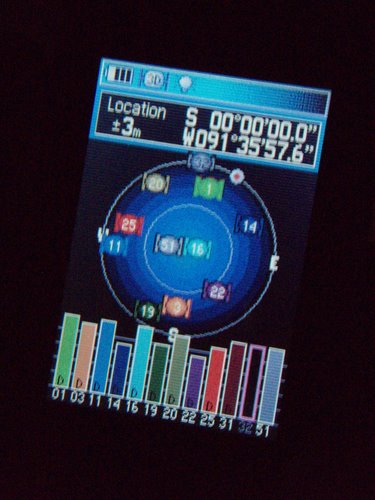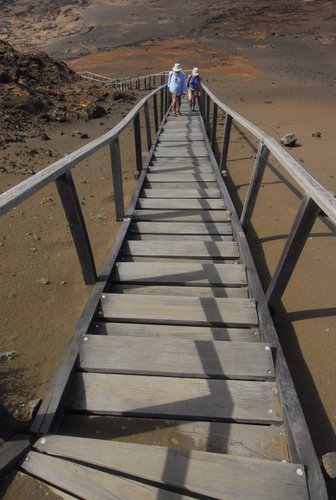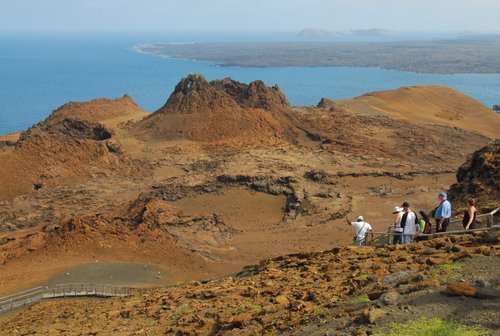Ecuador - Galapagos Islands - Where are the tropics anyway?

The Galapagos Islands are a part of the country of Ecuador so it made sense to learn that the equator crosses right through Ecuador on the mainland of South America. It just so happens that the equator also passes through the Galapagos Islands as well, way out in the Pacific Ocean (about 1000 kilometres west of the continent).
On our trip through the islands we crossed the equator twice (once going up the west coast of Isabela Island, and the other as we made our way down the east coast of Isabela) and there was a small ceremony on the bridge of our small ship to celebrate the ‘Crossing of the Line’. It is an age old tradition to celebrate the crossing of the equator for those travellers who have never done it before and in some cases crew members have to follow an elaborate initiation ceremony. For us though… we simply raised a glass to the crossing from one hemisphere to the next. I snapped a photo of my GPS (Global Positioning System) just as we crossed the equator (from the Southern Hemisphere into the Northern Hemisphere) at latitude 0 degrees, 0 minutes and 0 seconds.
The equator is the middle of the planet (by definition it is latitude 0 degrees) and is equidistant to both of the poles (the North and South Poles). There are other lines of latitude that you may be familiar with such as the Tropic of Cancer, the Tropic of Capricorn, the Arctic Circle and the Antarctic Circle.
You have likely heard the words tropical, temperate, Arctic and Antarctic but do you know what they refer to? These are all climatic regions of the planet that are determined by lines of latitude.
The tropics are regions of the world, on either side of the equator, that fall between the Tropic of Cancer (23.5 degrees north latitude) and the Tropic of Capricorn (23.5 degrees south latitude).
The world’s temperate regions fall between 23.5 degrees North and South latitudes to the Arctic circle in the northern hemisphere and the Antarctic circle in the southern hemisphere. To make the story complete, the Arctic extends northward from 66.5 degrees N latitude to the North Pole and the Antarctic extends southward from 66.5 degrees S latitude to the South Pole (the Arctic & Antarctic Circles though are not really the best ways to define the Arctic and Antarctic regions … but that is another story).
Some things are different on the equator than in other parts of the world. One thing that takes a bit of time getting used to is day length. On the equator there is no such thing as the long days of summer… or short days of winter… day length is the same year round… 12 hours of daylight… and 12 hours of night. Another difference is how fast the sun rises and sets. The sun rises and sets faster on the equator than anywhere else so you don’t get the long slow sunsets we are used to (at least that I am used to) being at the 49th parallel (49 degrees north latitude) in Vancouver. As someone who enjoys photography I can remember the first time that I spent time near the equator. I started watching a sunset and thought… hmmm… I should go get my camera, but by the time I came back it was pitch black! No dawn and dusk in the tropics!
And there is even a difference in how the water drains. If you go to the Mitad del Mundo (Centre of the Earth) near Quito, Ecuador you can see a fascinating demonstration where they show you how water drains clockwise north of the equator line … and counter-clockwise south of the equator line. They only move the wash basin a few metres… but you see the difference right before your eyes! And what happens to the water when the drain is put exactly on the equator? The water goes straight down the drain without any spinning at all! Pretty nifty I must say!

Our stay in the northern hemisphere was brief… only a matter of hours. From Isabela Island we made our way over to James and Bartolome Islands (where many of the scenes of the movie ‘Master and Commander’ were filmed). On Bartolome there are steps that lead you up to a fabulous viewpoint over the islands (well worth the effort) and you can get a real feel for the volcanic origins of the islands.

 Funded by TEK
Funded by TEK
I didn´t remember the Galapagos islands were so arid , I am learning a lot thanks to your pictures . Did you stop in Lonely Old George´s island? I am rewieing the NG I have from that time , ECUADOR is fascinating!.-
Thanks alot Danny,
Verónica